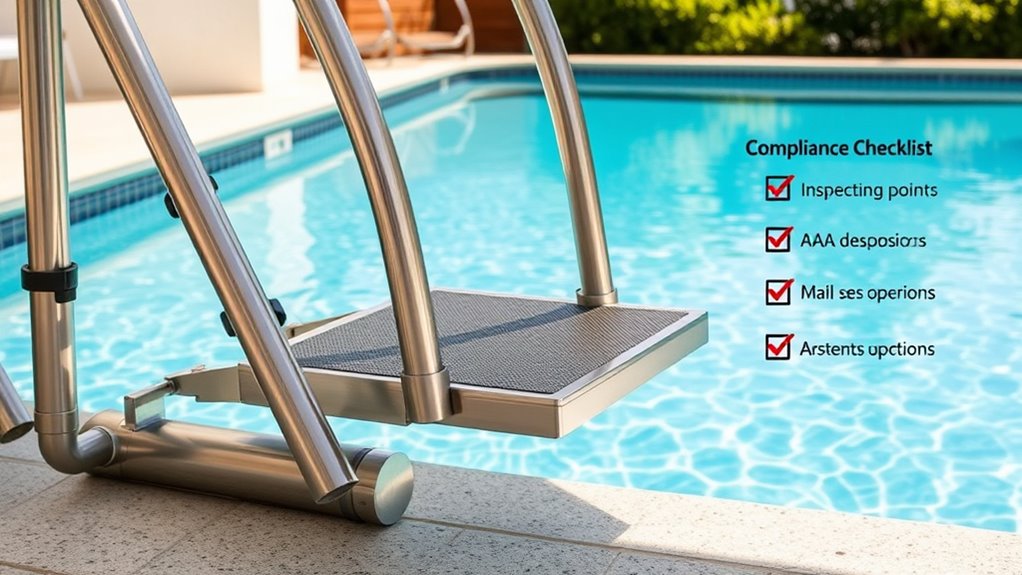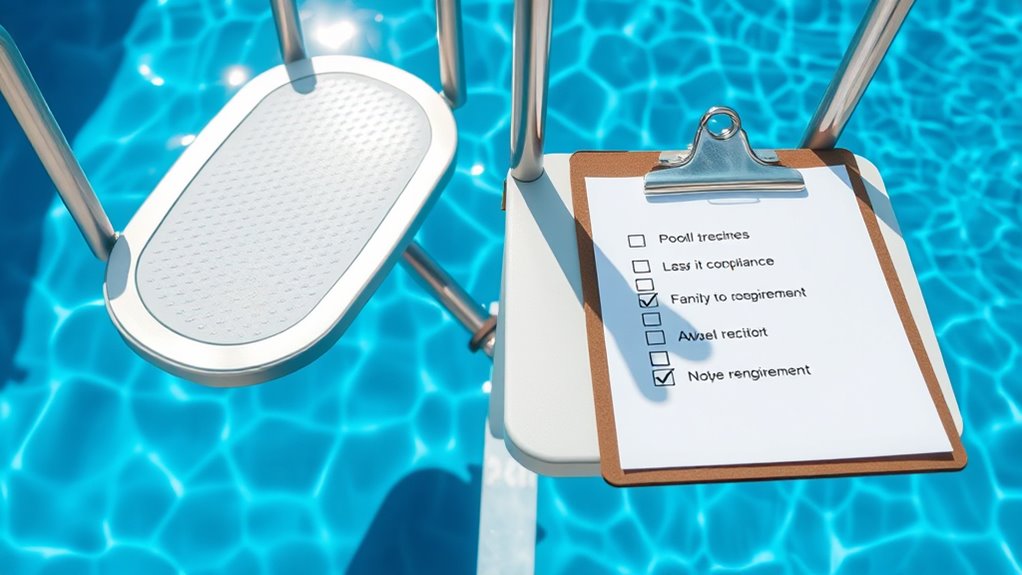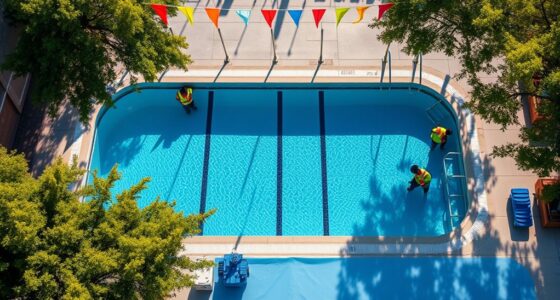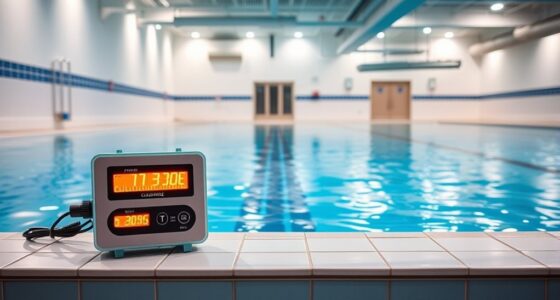To guarantee ADA pool lift compliance, make sure your lift is accessible and operable, with controls that are easy to reach, use, and clearly marked. It should have a secure, stable platform and a weight capacity of at least 300 pounds, made of corrosion-resistant materials. Proper installation and regular maintenance are vital for safety. Staff training on proper use and safety checks also help keep your facility compliant. Continue to explore all requirements to make your pool safe and accessible for everyone.
Key Takeaways
- Ensure pool lifts are accessible, operable, and allow easy transfer with controls that are reachable, marked, and operable with one hand.
- Verify the lift has a minimum weight capacity of 300 pounds and is made of corrosion-resistant materials suitable for pool environments.
- Properly install the lift near the pool edge with secure mounting to ensure stability and safety during use.
- Conduct routine inspections to verify functionality, inspect structural components, and document maintenance activities.
- Train staff on safe operation, emergency procedures, and maintenance protocols to promote safety and compliance.

Ensuring accessibility at swimming pools is vital, and the ADA pool lift requirements provide clear guidelines for compliance. When you’re making your pool accessible, maintaining proper pool safety is a top priority. The ADA standards emphasize that every person, regardless of physical ability, should have equal access to recreational facilities. This promotes an inclusive environment where all individuals can enjoy swimming safely. This means installing a pool lift that meets specific criteria to guarantee safety, reliability, and ease of use.
Your first step is understanding the key accessibility standards. The ADA specifies that pool lifts must be readily accessible, operable, and safe for users of all abilities. The lift should allow a person to transfer from a wheelchair or walking aid into the pool with minimal effort. It’s imperative that the lift’s controls are easy to reach, clearly marked, and operable with one hand, so users don’t encounter unnecessary difficulties. The guidelines also state that the lift must have a secure, stable platform to prevent slipping or falling during transfer, aligning with pool safety principles.
Ensure pool lifts are accessible, easy to operate, and provide a secure transfer for all users.
When selecting a pool lift, you need to guarantee it complies with specific technical standards. For instance, the lift should have a weight capacity that accommodates a wide range of users, typically at least 300 pounds, to promote inclusivity and safety. The equipment must be made of corrosion-resistant materials, like stainless steel or durable plastics, to withstand pool environments and prevent deterioration over time. Proper installation is critical; the lift should be positioned near the pool edge with a stable mounting base that prevents movement or instability during use.
Another essential aspect of ADA compliance involves regular maintenance and inspections. You should establish a routine check to verify the lift functions correctly and safely. This includes confirming that the controls work smoothly, the structural components are intact, and there are no signs of wear or damage. Maintaining proper documentation of inspections and repairs helps demonstrate compliance and ensures ongoing pool safety and accessibility standards are met. Additionally, training staff on proper use and emergency procedures can further enhance safety and accessibility.
Incorporating these ADA pool lift requirements into your facility isn’t just about legal compliance; it’s about fostering an inclusive environment where everyone can enjoy swimming safely. By installing a compliant lift, you help eliminate barriers for people with disabilities, ensuring they can access the pool with dignity and independence. Remember, adhering to accessibility standards not only enhances pool safety but also demonstrates your commitment to serving all members of your community, making your pool a welcoming, accessible space for everyone.
Frequently Asked Questions
Are Portable Pool Lifts Compliant With ADA Standards?
Yes, portable pool lifts can be compliant with ADA standards if they meet specific accessibility features and safety requirements. You should guarantee your mobility aids include features like secure locking mechanisms, easy operation, and stable support. Check that the lift complies with weight capacity and installation guidelines, and that it allows users of all abilities to access the pool independently and safely. Regular maintenance and proper placement are essential for ongoing ADA compliance.
What Is the Typical Cost to Install an Ada-Compliant Pool Lift?
You can expect to pay around $3,000 to $10,000 for installing an ADA-compliant pool lift, depending on the model and installation complexity. If you’re considering outdoor pool accessibility, explore pool lift financing options to ease costs. Keep in mind that proper installation guarantees legal compliance and safe access for all users, making it a worthwhile investment to enhance inclusivity and meet ADA standards.
How Often Should ADA Pool Lifts Be Inspected and Maintained?
Like a watchful guardian, you should inspect your ADA pool lift regularly, ideally weekly, to guarantee safety and proper functioning. You must also adhere to maintenance procedures, including checking for wear and tear, lubricating moving parts, and testing safety features. Frequent inspections help prevent accidents and ensure pool lift safety, keeping users secure. Staying proactive with maintenance reinforces your commitment to accessibility and compliance, avoiding costly repairs and potential liabilities.
Can Existing Pool Lifts Be Retrofitted to Meet ADA Requirements?
Yes, existing pool lifts can be retrofitted to meet ADA requirements through pool lift modifications. Accessibility upgrades often involve installing new hardware, adjusting controls, or adding features like transfer systems to improve safety and usability. You should consult with professionals experienced in ADA compliance to guarantee your modifications meet all legal standards. Retrofitting helps you provide equitable access, making your pool more inclusive for all users.
Are There Specific Signage Requirements for ADA Pool Lifts?
Yes, there are specific signage requirements for ADA pool lifts. You need to guarantee signage is highly visible, with clear, easy-to-read instructions. The signage should display instructional information on how to operate the lift safely and be positioned near the lift for quick access. Proper signage helps users understand the lift’s operation and complies with ADA standards, promoting safety and accessibility for everyone.
Conclusion
Now that you’re equipped with the ADA pool lift requirements, you’re like a skilled captain steering your facility toward compliance. Keep the checklist close, and let each step be a guiding star on your journey. With attention to detail and a commitment to accessibility, you transform your pool area into a welcoming oasis for all. Stay vigilant, and watch as your efforts ripple outward, creating waves of inclusivity that echo far beyond the water’s edge.









